High dose rate versus low dose rate intracavity brachytherapy for locally advanced uterine cervix cancer
- PMID: 25300170
- PMCID: PMC8734152
- DOI: 10.1002/14651858.CD007563.pub3
High dose rate versus low dose rate intracavity brachytherapy for locally advanced uterine cervix cancer
Abstract
Background: This is an updated version of the original Cochrane review published in 2010 (Issue 7).Carcinoma of the uterine cervix is the second most common cancer and the third leading cause of cancer death among women. Radiotherapy has been used successfully to treat cervical cancer for nearly a century. The combination of external beam radiotherapy (EBRT) and intracavity brachytherapy (ICBT) has become a standard treatment for cervical cancer. Whether high dose rate (HDR) or low dose rate (LDR) brachytherapy improves outcomes in terms of local control rates, survival and complications for women with cervical cancer remains controversial.
Objectives: To assess the efficacy and safety of HDR versus LDR ICBT in combination with EBRT for women with uterine cervical cancer.
Search methods: We searched the Cochrane Gynaecological Cancer Group Specialised Register and the Cochrane Central Register of Controlled Trials (CENTRAL) (The Cochrane Library 2014, Issue 1), MEDLINE (1966 to March 2014), EMBASE (1974 to March 2014), and the Chinese Biomedical Literature Database (CBM) (1978 to March 2014) for relevant original, published trials.
Selection criteria: Randomised controlled trials (RCTs) and quasi-RCTs that compared HDR with LDR ICBT, combined with EBRT, for women with locally advanced uterine cervical cancer.
Data collection and analysis: Two authors independently extracted the data using standardised forms. Primary outcome measures included overall survival (OS), relapse-free survival (RFS) and pelvic control rate, while secondary outcomes included rates of recurrence and complications.
Main results: Four studies involving 1265 women met the inclusion criteria. In our meta-analysis to compare HDR and LDR ICBT, the pooled risk ratios (RRs) were 0.95 (95% confidence interval (CI) 0.79 to 1.15), 0.93 (95% CI 0.84 to 1.04) and 0.79 (95% CI 0.52 to 1.20) for 3-, 5- and 10-year overall survival rates respectively; and 0.95 (95% CI 0.84 to 1.07) and 1.02 (0.88 to 1.19) for 5- and 10-year disease-specific survival (DSS) rates respectively. The RR for RFS was 1.04 (95% CI 0.71 to 1.52) and 0.96 (95% CI 0.81 to 1.14) at 3- and 5- years. For local control rates the RR was 0.95 (95% CI 0.86 to 1.05) and 0.95 (95% CI 0.87 to 1.05) at 3- and 5- years; with a RR of 1.09 (95% CI 0.83 to 1.43) for locoregional recurrence, 0.79 (95% CI 0.40 to 1.53) for local and distant recurrence, 2.23 (95% CI 0.78 to 6.34) for para-aortic lymph node metastasis, and 0.99 (95% CI 0.72 to 1.35) for distance metastasis. For bladder, rectosigmoid and small bowel complications, the RR was 1.33 (95% CI 0.53 to 3.34), 1.00 (95% CI 0.52 to 1.91) and 3.37 (95% CI 1.06 to 10.72) respectively. These results indicated that there were no significant differences except for increased small bowel complications with HDRs (P = 0.04).
Authors' conclusions: Since the last version of this review, no new studies were identified for inclusion in this review to provide additional information. This review showed no significant differences between HDR and LDR ICBT when considering OS, DSS, RFS, local control rate, recurrence, metastasis and treatment related complications for women with cervical carcinoma. Due to some potential advantages of HDR ICBT (rigid immobilization, outpatient treatment, patient convenience, accuracy of source and applicator positioning, individualized treatment) we recommend the use of HDR ICBT for all clinical stages of cervix cancer. The overall risk of bias was high for the included studies as many of the items were either of high or unclear risk. The GRADE assessment of the quality of the evidence was low to moderate.
Conflict of interest statement
None known
Figures


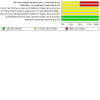


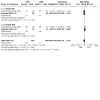
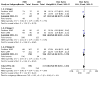


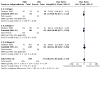
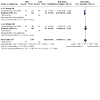


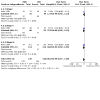



Update of
-
High dose rate versus low dose rate intracavity brachytherapy for locally advanced uterine cervix cancer.Cochrane Database Syst Rev. 2010 Jul 7;(7):CD007563. doi: 10.1002/14651858.CD007563.pub2. Cochrane Database Syst Rev. 2010. Update in: Cochrane Database Syst Rev. 2014 Oct 09;(10):CD007563. doi: 10.1002/14651858.CD007563.pub3. PMID: 20614461 Updated.
References
References to studies included in this review
Hareyama 2002 {published data only}
-
- Hareyama M, Sakata K, Oouchi A, Nagakura H, Shido M, Someya M et al. High-dose-rate versus low-dose-rate intracavitary therapy for carcinoma of the uterine cervix: a randomized trial. Cancer 2002;94(1):117-24. - PubMed
Lertsanguansinchai 2004 {published data only}
-
- Lertsanguansinchai P, Lertbutsayanukul C, Shotelersuk K, Khorprasert C, Rojpornpradit P, Chottetanaprasith T et al. Phase III randomized trial comparing LDR and HDR brachytherapy in treatment of cervical carcinoma. International Journal of Radiation Oncology, Biology, Physics 2004;59(5):1424-31. - PubMed
Patel 1994 {published data only}
-
- Patel FD, Sharma SC, Negi PS, Ghoshal S, Gupta BD. Low dose rate vs. high dose rate brachytherapy in the treatment of carcinoma of the uterine cervix: a clinical trial. International Journal of Radiation Oncology, Biology, Physics 1994;28(2):335-41. - PubMed
Teshima 1993 {published data only}
-
- Teshima T, Inoue T, Ikeda H, Miyata Y, Nishiyama K, Inoue T et al. High-dose rate and low-dose rate intracavitary therapy for carcinoma of the uterine cervix: Final results of Osaka University Hospital. Cancer 1993;72(8):2409-14. - PubMed
References to studies excluded from this review
Chatani 1991 {published data only}
-
- Chatani M, Teshima T, Inoue T. A prospective randomized study concerning to the point A dose in high-dose rate intracavitary radiation therapy for carcinoma of the uterine cervix. Strahlentherapie und Onkologie 1991;167(12):701-7. - PubMed
el‐Baradie 1997 {published data only}
-
- el-Baradie M, Inoue T, Inoue T, Murayama S, Tang JT, Yamazaki H et al. HDR and MDR intracavitary treatment for carcinoma of the uterine cervix. A prospective randomized study. Strahlentherapie und Onkologie 1997;173(3):155-62. - PubMed
Falkenberg 2006 {published data only}
-
- Falkenberg E, Kim RY, Meleth S, De Los Santos J, Spencer S. Low-dose-rate vs.high-dose-rate intracavitary brachytherapy for carcinoma of the cervix: The University of Alabamaat Birmingham (UAB) experience. Brachytherapy 2006;5(1):49-55. - PubMed
Ferrigno 2005 {published data only}
-
- Ferrigno R, Nishimoto IN, Novaes PE, Pellizzon AC, Maia MA, Fogarolli RC et al. Comparison of low and high dose rate brachytherapy in the treatment of uterine cervix cancer. Retrospective analysis of two sequential series. International Journal of Radiation Oncology, Biology, Physics 2005;62(4):1108-16. - PubMed
Fu 1990 {published data only}
-
- Fu KK, Phillips TL. High-dose-rate versus low-dose-rate intracavitary brachytherapy for carcinoma of the cervix. International Journal of Radiation Oncology, Biology, Physics 1990;19(3):791-6. - PubMed
Inoue 1977 {published data only}
-
- Inoue T, Hori S, Miyata Y, Ozeki S, Shigematsu Y. High versus low dose rate intracavitary irradiation of carcinoma of the uterine cervix: a preliminary report. Acta Radiologica. Oncology 1977;17:277-82. - PubMed
Kim 2001 {published data only}
-
- Kim WC, Kim GE, Suh CO, Loh JJ. High versus low dose rate intracavitary irradiation for adenocarcinoma of the uterine cervix. Japanese Journal of Clinical Oncology 2001;31(9):432-7. - PubMed
Kucera 2001 {published data only}
-
- Kucera H, Potter R, Knocke TH, Baldass M, Kucera E. High-dose versus low-dose rate brachytherapy in definitive radiotherapy of cervical cancer. Wiener Klinische Wochenschrift 2001;113(1-2):58-62. - PubMed
Lambin 1994 {published data only}
-
- Lambin P, Gerbaulet A, Kramar A, Scalliet P, Haie-Meder C, Michel G et al. A comparison of early effects with two dose rates in brachytherapy of cervix carcinoma in a prospective randomised trial. European Journal of Cancer 1994;30A(3):312-20. - PubMed
Nam 2004 {published data only}
Okkan 2003 {published data only}
-
- Okkan S, Atkovar G, Sahinler I, Oner Dincbas F, Koca A, Koksal S et al. Results and complications of high dose rate and low dose rate brachytherapy in carcinoma of the cervix: Cerrahpaşa experience. Radiotherapy and Oncology 2003;67(1):97-105. - PubMed
Petereit 1999 {published data only}
-
- Petereit DG, Sarkaria JN, Potter DM, Schink JC. High-dose-rate versus low-dose-rate brachytherapy in the treatment of cervical cancer: analysis of tumor recurrence - the University of Wisconsin experience. International Journal of Radiation Oncology, Biology, Physics 1999;45(5):1267-74. - PubMed
Sarkaria 1994 {published data only}
-
- Sarkaria JN, Petereit DG, Stitt JA, Hartman T, Chappell R, Thomadsen BR et al. A comparison of the efficacy and complication rates of low dose-rate versus high dose-rate brachytherapy in the treatment of uterine cervical carcinoma. International Journal of Radiation Oncology, Biology, Physics 1994;30(1):75-82. - PubMed
Shigematsu 1983 {published data only}
-
- Shigematsu Y, Nishiyama K, Masaki N, Inoue T, Miyata Y, Ikeda H et al. Treatment of carcinoma of the uterine cervix by remotely controlled afterloading intracavitary radiotherapy with high-dose rate: a comparative study with a low-dose rate system. International Journal of Radiation Oncology, Biology, Physics 1983;9(3):351-6. - PubMed
Shrivastava 2006 {published data only}
-
- Shrivastava S, Dinshaw K, Mahantshetty U, Engineer R, Patil N, Deshpande D et al. Comparing low-dose-rate and high-dose-rate intracavitary brachytherapy in carcinoma cervix: Results from a randomized controlled study. International Journal of Radiation Oncology, Biology, Physics 2006;66(3):S42.
Stewart 2006 {published data only}
-
- Stewart AJ, Viswanathan AN. Current controversies in high-dose-rate versus low-dose-rate brachytherapy for cervical cancer. Cancer 2006;107(5):908-15. - PubMed
Wong 2003 {published data only}
-
- Wong FC, Tung SY, Leung TW, Sze WK, Wong VY, Lui CM et al. Treatment results of high-dose-rate remote afterloading brachytherapy for cervical cancer and retrospective comparison of two regimens. International Journal of Radiation Oncology, Biology, Physics 2003;55(5):1254-64. - PubMed
Additional references
Arai 1992
-
- Arai T, Nakano T, Morita S, Sakashita K, Nakamura YK, Fukuhisa K. High-dose-rate remote afterloading intracavitary radiation therapy for cancer of the uterine cervix. A 20-year experience. Cancer 1992;69(1):175-80. - PubMed
Aristizabal 1983
-
- Aristizabal SA, Surwit E, Valencia A, Hevezi J. Treatment of locally advanced cancer of the cervix with transperineal interstitial irradiation. Report on 106 cases. American Journal of Clinical Oncology 1983;6(6):645-50. - PubMed
Barrillot 1997
-
- Barillot I, Horiot JC, Pigneux J, Schraub S, Pourquier H, Daly N et al. Carcinoma of the intact uterine cervix treated with radiotherapy alone: French cooperative study: Update and multi-variate analysis of prognostic factor. International Journal of Radiation Oncology, Biology, Physics 1997;38:969-78. - PubMed
Benedet 2000
-
- Benedet JL, Bender H, Jones H 3rd, Ngan HY, Pecorelli S. FIGO staging classifications and clinical practice guidelines in the management of gynecologic cancers. FIGO Committee on Gynecologic Oncology. International Journal of Gynaecology and Obstetrics 2000 Aug;70(2):209-62. - PubMed
Bosch 2003
-
- Bosch FX, De Sanjose S. Chapter 1: Human papillomavirus and cervical cancer burden and assessment of causality. In: Journal of the National Cancer Institute Monographs. Vol. 31. Oxford University Press, 2003:3-13. - PubMed
Brenner 1991
-
- Brenner DJ, Hall EJ. Fractionated high dose rate versus low dose rate regimens for intracavitary brachytherapy of the cervix. I. General considerations based on radiobiology. British Journal of Radiology 1991;64:133-41. - PubMed
Cox 1995
-
- Cox JD, Stetz J, Pajak TF. Toxicity criteria of the Radiation Therapy Oncology Group (RTOG) and the European Organization for Research and Treatment of Cancer (EORTC) [editorial]. International Journal of Radiation Oncology, Biology, Physics 1995;31:1341-6. - PubMed
Dale 1990
-
- Dale RG. The use of small fraction numbers in high dose rate gynaecological afterloading: Some radiobiological considerations. British Journal of Radiology 1990;63:290-4. - PubMed
Davidson 1990
-
- Davidson SE, West CM, Roberts SA, Hendry JH, Hunter RD. Radiosensitivity testing of primary cervical carcinoma: evaluation of intra- and inter-tumour heterogeneity. Radiotherapy and Oncology 1990;18(4):349-56. - PubMed
Demanes 1999
-
- Demanes DJ, Rodriguez RR, Bendre DD, Ewing TL. High dose rate transperineal interstitial brachytherapy for cervical cancer: high pelvic control and low complication rates. International Journal of Radiation Oncology, Biology, Physics 1999;45:105-12. - PubMed
Dickersin 1992
-
- Dickersin K, Min Y-I, Meinert CL. Factors influencing publication of research results. JAMA 1992;267(3):374-8. - PubMed
Dinniwell 2004
-
- Dinniwell R, Chan P, Milosevic M et al. Assessment of radiotherapy response using magnetic resonance imaging tumor volumetry in carcinoma of the uterine cervix. Radiation Oncology 2004;72 Suppl:58.
Easterbrook 1991
-
- Easterbrook PJ, Berlin JA, Gopalan R, Matthews DR. Publication bias in clinical research. Lancet 1991;337(8746):867-72. - PubMed
Eifel 1994
-
- Eifel PJ, Morris M, Wharton JT, Oswald MJ. The influence of tumour size and morphology on the outcome of patients with FIGO stage IB squamous cell carcinoma of the uterine cervix. International Journal of Radiation Oncology, Biology, Physics 1994;29:9-16. - PubMed
Falagas 2009
-
- Falagas ME, Grigori T, Ioannidou E. A systematic review of trends in the methodological quality of randomised controlled trials in various research fields. Journal of Clinical Epidemiology 2009;62(3):227-31. - PubMed
Fyles 1995
-
- Fyles AW, Pintilie M, Kirkbridge P. Prognostic factors in patients with cervix cancer treated by radiation therapy: Results of a multiple regression analysis. Radiotherapy and Oncology 1995;35:107-17. - PubMed
GRADEpro 2008 [Computer program]
-
- GRADE Working Group GRADEpro Version 3.2 for Windows. Brozek J, Oxman A, Schünemann H. GRADE Working Group, 2008.
Green 2005
Hashimoto 1980
-
- Hashimoto S. Intracavitary radiotherapy using remote afterloading technique (author's translation). Radioisotopes 1980;29(2):103-10. - PubMed
Henschke 1966
-
- Henschke UK, Hilaris BS, Mahan GD. Intracavitary radiation therapy of cancer of the uterine cervix by remote afterloading with cycling sources. American Journal of Roentgenology, Radium Therapy and Nuclear Medicine 1966;96(1):45-51. - PubMed
Higgins 2011
-
- Higgins JPT, Green S, editors. Cochrane Handbook for Systematic Reviews of Interventions Version 5.1.0 [updated March 2011]. The Cochrane Collaboration, 2011. Available from www.cochrane-handbook.org.
Hong 1992
-
- Hong JH, Chen MS, Lin FJ, Tang SG. Prognostic assessment of tumor regression after external irradiation for cervical cancer. International Journal of Radiation Oncology, Biology, Physics 1992;22:913-7. - PubMed
Hsu 1998
-
- Hsu HC, Leung SW, Huang EY, Wang CJ, Sun LM, Fang FM et al. Impact of the extent of parametrial involvement in patients with carcinoma of the uterine cervix. International Journal of Radiation Oncology, Biology, Physics 1998;40:405-10. - PubMed
Hughes‐Davies1995
-
- Hughes-Davies L, Silver B, Kapp DS. Parametrial interstitial brachytherapy for advanced or recurrent pelvic malignancy: the Harvard/Stanford experience. Gynecologic Oncology 1995;58(1):24-7. - PubMed
ICRU 1985
-
- International Commission on Radiation Units and Measurements (ICRU). Dose and volume specifications for reporting intracavitary therapy in gynecology (Report 38). International Commission on Radiation Units and Measurements, Inc. (ICRU) 1985:ICRU Report 38.
Juni 2001
Kim 1997
-
- Kim RY, Caranto JF, Tucker JC. Image-based intracavitary brachytherapy in cancer of the cervix: Analysis of CT-based tumor coverage by pear-shaped isodose dimensions. International Journal of Radiation Oncology, Biology, Physics 1997;39:299. - PubMed
Kim 2000
-
- Kim RY, Spencer SA. Tumour shrinkage before intracavitary brachytherapy for cancer of the cervix: Radiotherapy alone versus concurrent chemo-radiotherapy. Cancer 2000;6:377-80. - PubMed
Kirisits 2006
-
- Kirisits C, Lang S, Dimopoulos J, Berger D, Georg D, Pötter R. The Vienna applicator for combined intracavitary and interstitial brachytherapy of cervical cancer: design, application, treatment planning, and dosimetric results. International Journal of Radiation Oncology, Biology, Physics 2006;65(2):624-30. - PubMed
Kottmeier 1961
-
- Kottmeier HL, Gray MJ. Rectal and bladder injuries in relating to radiation dosage in carcinoma of the uterine cervix: a 5 year follow-up. American Journal of Obstetrics and Gynecology 1961;82:74-82. - PubMed
Lee 2004
-
- Lee CM, Shrieve DC, Gaffney DK. Rapid involution and mobility of carcinoma of the cervix. International Journal of Radiation Oncology, Biology, Physics 2004;58:625-30. - PubMed
Lin 2005
-
- Lin LL, Mutic S, Malyapa RS, Low DA, Miller TR, Vicic M. Sequential FDG-PET brachytherapy treatment planning in carcinoma of the cervix. International Journal of Radiation Oncology, Biology, Physics 2005;63(5):1494-501. - PubMed
Mayr 1997
-
- Mayr NA, Yuh WT, Zheng J, Ehrhardt JC, Sorosky JI, Magnotta VA et al. Tumor size evaluated by pelvic examination compared with 3-D MR quantitative analysis in the prediction of outcome for cervical cancer. International Journal of Radiation Oncology, Biology, Physics 1997;39:395-404. - PubMed
Nag 1999
-
- Nag S, Orton C, Young D, Erickson B. The American Brachytherapy Society survey of brachytherapy practice for carcinoma of the cervix in the United States. Gynecologic Oncology 1999;73(1):111-8. - PubMed
O'Connell 1965
-
- O'Connell D, Howard N, Joslin CA, Ramsey NW, Liversage WE. A new remotely controlled unit for the treatment of uterine carcinoma. Lancet 1965;2(7412):570-1. - PubMed
Okawa 1992
-
- Okawa I, Sakata S, Kita-Okawa M. Comparison of HDR versus LDR regimens for intracavitary brachytherapy of cervical cancer: Japanese experience. In: Mould RF, editors(s). International Brachytherapy. Veenendaal, The Netherlands: Nucletron B.V., 1992:13-7.
Orton 1991
-
- Orton CG, Seyedsadr M, Somnay A. Comparisons of high and low dose rate remote afterloading for cervix cancer and the importance of fractionation. International Journal of Radiation Oncology, Biology, Physics 1991;21:1425-34. - PubMed
Orton 1998
-
- Orton CG. High and low dose-rate brachytherapy for cervical carcinoma. Acta Oncologica 1998;37:117-25. - PubMed
Park 2002
-
- Park HC, Suh CO, Kim GE. Fractionated high-dose-rate brachytherapy in the management of uterine cervical cancer. Yonsei Medical Journal 2002;43(6):737-48. - PubMed
Park 2009
-
- Park D, Kim YS, Park SH, Choi EK, Ahn SD, Lee S et al. A comparison of dose distributions of HDR intracavitary brachytherapy using different sources and treatment planning systems. Applied Radiation and Isotopes 2009;67:1426-31. - PubMed
Patone 2008
-
- Patone H, Souhami L, Parker W, Evans M, Duclos M, Portelance L. A dosimetric comparison of two high-dose-rate brachytherapy planning systems in cervix cancer: standardized template planning vs. computerized treatment planning. Brachytherapy 2008;7(3):254-9. - PubMed
Perez 1992
-
- Perez CA, Grigsby PW, Nene SM, Camel HM, Galakatos A, Kao MS et al. Effect of tumor size on the prognosis of carcinoma of the uterine cervix treated with irradiation alone. Cancer 1992;69:2796-806. - PubMed
Petignat 2007
RevMan 2011 [Computer program]
-
- The Nordic Cochrane Centre, The Cochrane Collaboration Review Manager (RevMan). 5.1. Copenhagen:. The Nordic Cochrane Centre, The Cochrane Collaboration, 2011.
Rotte 1991
-
- Rotte K. Comparison of HDR afterloading and classical radium techniques for radiation therapy of cancer of the cervix uteri. Acta Selective Brachytherapy 1991;2 Suppl:42-6.
Shin 2006
-
- Shin KH, Kim TH, Cho JK, Kim JY, Park SY, Park SY et al. CT-guided intracavitary radiotherapy for cervical cancer: Comparison of conventional point A plan with clinical target volume-based three-dimensional plan using dose-volume parameters. International Journal of Radiation Oncology, Biology, Physics 2006;64(1):197-204. - PubMed
Tanderup 2008
-
- Tanderup K, Hellebust TP, Lang S, Granfeldt J, Potter R, Lindegaard JC et al. Consequences of random and systematic reconstruction uncertainties in 3D image based brachytherapy in cervical cancer. Radiotherapy and Oncology 2008;89(2):156-63. - PubMed
Torres 2004
-
- Torres LA, Rojo HG, Torres RA, Hurtado EG, Román BE. [Cervical cancer: Current view of its epidemiology and risk factors]. Ginecologia y Obstetricia de Mexico 2004;72:466-74. - PubMed
Yaparpalvi 2008
-
- Yaparpalvi R, Mutyala S, Gorla GR, Butler J, Mah D, Garg MK et al. Point vs. volumetric bladder and rectal doses in combined intracavitary-interstitial high-dose-rate brachytherapy: correlation and comparison with published Vienna applicator data. Brachytherapy 2008;7(4):336-42. - PubMed
Publication types
MeSH terms
LinkOut - more resources
Full Text Sources
Other Literature Sources
Medical
Miscellaneous

